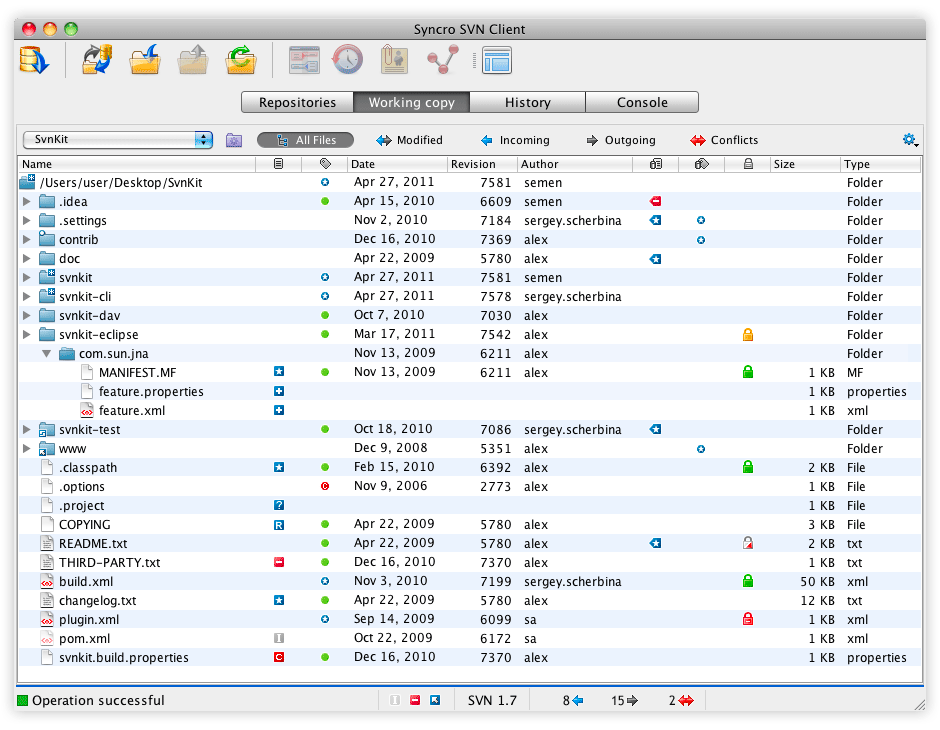

# ssl-authority-files = /path/to/CAcert.pem /path/to/CAcert2.This is a workaround to fix a problem I had with my svn client after upgrading to Eclipse Ganymede and Subclipse plugin last week. # No neon-debug-mask, so neon debugging is disabled. # No http-timeout, so just use the builtin default. # http-proxy-exceptions = *., # http-proxy-host = In ~/.subversion/servers file :- (Changed as)

# Section for configuring external helper applications. # is overridden by settings specified in the 'servers' file. # specified in the 'servers' file in your config directory # Both 'store-passwords' and 'store-auth-creds' can now be # The rest of the section in this file has been deprecated. # expected place (see the 'ssl-client-cert-file' option in the # requests a client cert but no client cert file is found in the # to prompt for a path to a client cert file when the server # Set ssl-client-cert-file-prompt to 'yes' to cause the client
Svn client for ubuntu password#
# To disable all password stores, use an empty list: Password-stores = gpg-agent,gnome-keyring,kwallet # the order in which password stores are used. # Set password stores used by Subversion. In ~/.subversion/config file :- (Changed as) # Section for authentication and authorization customizations. Now subversion should be able to read from gnome-keyring, and you no longer need to type the password every time! You can use seahorse to check if everything was successful. "domain" has to match with certificate path in svn config that we just created. This will create a network password in default keychain. em_create_sync(None, gnomekeyring.ITEM_NETWORK_PASSWORD, "svn cert pwd",, "Secret_Passphrase_Goes_Here", True) Debian/Ubuntu users need "python-gnomekeyring" package for this to work. Since seahorse was incapable of creating a network password entry for me, I used a tiny python script. Now the tricky part - manually saving passphrase into gnome-keyring. Also make sure to replace V 33 with length of your path string. The path may be different in your case obivously. strace svn up and you should see something like "/home/user/.subversion/auth/-passphrase/b97ec2acbc64a5c8634a2307cd100b13". Ssl-authority-files = /some/path/to/CA_if_needed.pemįind which file svn is trying to read. Ssl-client-cert-file = /mnt/data/myuser/certificate.pk12 subversion/servers: store-auth-creds = yes Most of the steps are the same:Ĭontents of. Inspired by the above solution I managed to make it work with gnome-keyring. Note that my username isĭerived from the certificate common name, otherwise I think you as the password key.

Watch where svn is trying to retrieve the data from "strace -e Type in password into kwallet for this key Select "Passwords" within Subversion folder and create new one with.Open default wallet and create new top-level "Subversion" folder.Run "kwalletmanager", open kwallet via "system tray".subversion/config: section set to "password-stores = kwallet"
Svn client for ubuntu manual#
Given what you told me, I was able to find a workaround and manual There is a very nice how-to: Reposting the steps here, all credit to original author - Simon. One solution is to use kwallet as a password store. I'm answering this here in hope that somebody will find it useful and save some time. There seems to be a bug/regression in subversion 1.8+ where it fails to store certificate passphrase.


 0 kommentar(er)
0 kommentar(er)
